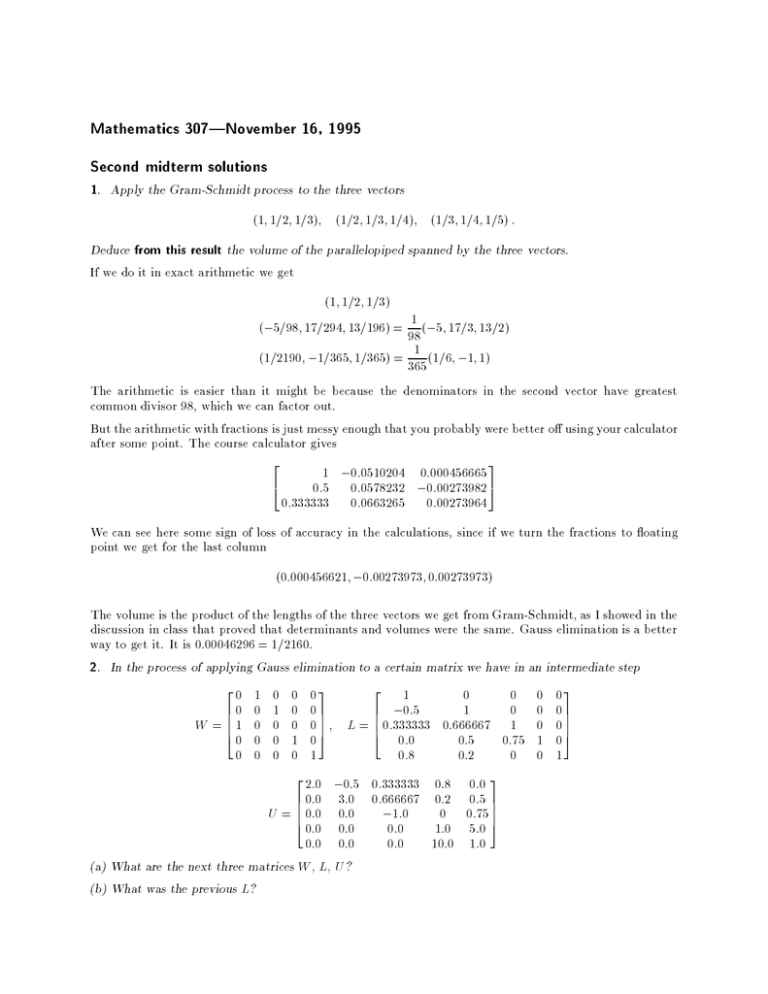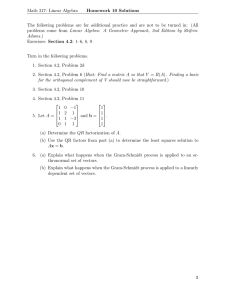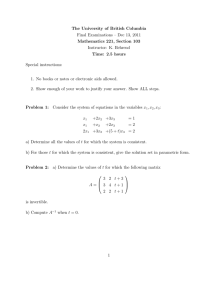Mathematics 307|November 16, 1995 Second midterm solutions 1 from this result
advertisement

Mathematics 307|November 16, 1995 Second midterm solutions 1. Apply the Gram-Schmidt process to the three vectors (1; 1=2; 1=3); (1=2; 1=3; 1=4); (1=3; 1=4; 1=5) : Deduce from this result the volume of the parallelopiped spanned by the three vectors. If we do it in exact arithmetic we get (1; 1=2; 1=3) 1 (,5; 17=3; 13=2) (,5=98; 17=294; 13=196) = 98 1 (1=6; ,1; 1) (1=2190; ,1=365; 1=365) = 365 The arithmetic is easier than it might be because the denominators in the second vector have greatest common divisor 98, which we can factor out. But the arithmetic with fractions is just messy enough that you probably were better o using your calculator after some point. The course calculator gives 2 3 1 ,0:0510204 0:000456665 4 0:5 0:0578232 ,0:00273982 5 0:333333 0:0663265 0:00273964 We can see here some sign of loss of accuracy in the calculations, since if we turn the fractions to oating point we get for the last column (0:000456621; ,0:00273973; 0:00273973) The volume is the product of the lengths of the three vectors we get from Gram-Schmidt, as I showed in the discussion in class that proved that determinants and volumes were the same. Gauss elimination is a better way to get it. It is 0:00046296 = 1=2160. 2. In the process of applying Gauss elimination to a certain matrix we have in an intermediate step 20 60 W = 664 1 0 0 1 0 0 0 0 0 1 0 0 0 0 0 0 1 0 2 03 1 0 0 0 77 1 0 6 ,0:5 0 75 ; L = 664 0:333333 0:666667 1 0 0:0 0:5 0:75 1 0:8 0:2 0 2 2:0 ,0:5 0:333333 6 0:0 3:0 0:666667 U = 664 0:0 0:0 ,1:0 0:0 0:0 0:0 0:0 0:0 0:0 (a) What are the next three matrices W , L, U ? (b) What was the previous L? 0:8 0:2 0 1:0 10:0 0:0 3 0:5 7 0:75 775 5:0 1:0 0 0 0 1 0 03 0 77 0 75 0 1 Second midterm solutions 2 (a) According to the strict pivot rules, we must swap the last two rows of U . We must also swap the last two rows of W and the last two non-trivial parts of L. The we subtract 1=10 the 3rd row from the 4th. 20 60 W = 664 1 0 0 1 0 0 0 0 0 1 0 0 0 0 0 0 0 1 2 03 1 0 0 0 0 77 1 0 0 6 ,0:5 0 75 ; L = 664 0:333333 0:666667 1 0 1 0:8 0:2 0 1 0 0:0 0:5 0:75 0:10 2 2:0 6 0:0 U = 664 0:0 0:0 0:0 ,0:5 0:333333 0:8 3:0 0:666667 0:2 0:0 ,1:0 0 0:0 0:0 10:0 0:0 0:0 0 03 0 77 0 75 0 1 0:0 3 0:5 7 0:75 775 1:0 4:9 (b) The history of swaps is 1 $ 2, 2 $ 3. There was no swap on the previous step, so the previous L was just 2 1 0 0 0 03 1 0 0 07 6 ,0:5 L = 664 0:333333 0:666667 1 0 0 775 0:0 0:5 0 1 0 0:8 0:2 0 0 1 3. If 2 1 0 0 03 1 1 0 07 L = 64 , ,2 ,2 1 0 5 ,3 3 1 1 , 1 explain how to calculate L in a simple and ecient way. Do it, showing all intermediate steps. We can write 2 1 0 0 0321 0 0 0321 0 0 03 1 1 0 0760 1 0 0760 1 0 07 L = 64 , , 2 0 1 0 5 4 0 ,2 1 0 5 4 0 0 1 0 5 ,3 0 0 1 0 3 0 1 0 0 1 1 which means that 21 0 0 0321 0 0 0321 0 0 03 2 1 0 0 03 L,1 = 64 00 10 01 00 75 64 00 12 01 00 75 64 12 10 01 00 75 = 64 14 12 01 00 75 ,4 ,5 ,1 1 0 0 ,1 1 0 ,3 0 1 3 0 0 1 4. In the (x; y; z ) coordinate system, the matrix of a certain linear transformation is 2 3 ,2 ,1 ,2 M = 4 ,3 0 ,2 5 6 2 5 Now make up a new basis from the vectors whose coordinates in the (x; y; z ) system are (0; ,2; 1), (2; 0; ,3). (0; 0; 1). (a) What is the matrix of T in this system? Second midterm solutions 3 (b) Use the previous result to nd a matrix X such that X ,1 MX is one of the standard forms, and write down that form. This was on the previous exam! Call u1 , u2, u3 the vectors of the new basis F . Thus 2 3 2 3 0 2 0 0 ,1=2 0 F = 4 ,2 0 0 5 ; F ,1 = 4 1=2 0 05 1 ,3 1 3=2 1=2 1 since the determinant of F is 4. The new matrix is F ,1ME F which is 2 3 1 0 1 4 0 1 ,1 5 0 0 1 This is very near a standard form. It says that Tu1 = u1 Tu2 = u2 Tu3 = u3 , u2 + u1 and a slight change of basis v1 = u1, v2 = ,u2 + u1 , v3 = u3 makes it into the standard form 2 3 1 0 0 40 1 15 0 0 1 Therefore we choose X to be the matrix whose columns are u1; ,u2 + u1; u3 2 3 0 ,2 0 X = 4 ,2 ,2 0 5 1 4 1 5. Sketch carefully the image of the unit circle transformed by the linear transformation whose matrix is 1 1 1 2 Put in as much detail as you can. The point is that the image is easy to draw if we choose our coordinates so the matrix becomes diagonal. The characteristic polynomial is 2 , 3 + 1 so the eigenvalues are p (3=2) 5=2 = 2:61; 0:381 The eigenvector equation is (1 , )x + y = 0 and the eigenvector p for is (1; , 1). So the image is an ellipse with major axis along the eigenvector line for = (3=2) + 5=2 and semi-major axis length of . The minor axis is perpendicular to this. Second midterm solutions 4 6. Explain how to calculate easily by hand the 100-th power of the matrix A = 21 12 and then nd it. In a sense this question is the same as the previous one, because the point of this one, too, is to chhose coordinates well. We have 1 1 1 0 1 = 2 , 1 = 2 A = ,1 1 0 3 1=2 1=2 A 100 since = ,11 11 1 0 0 3100 1=2 ,1=2 1=2 1=2 XAX ,1 XBX ,1 = X AB X ,1 Geometrically, A100 is a huge scale change in the same directions as for A.



